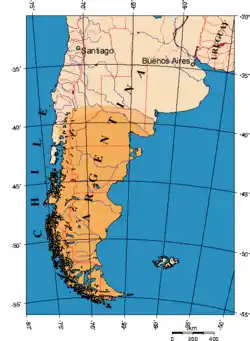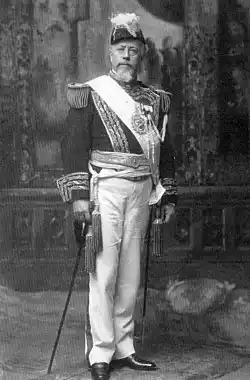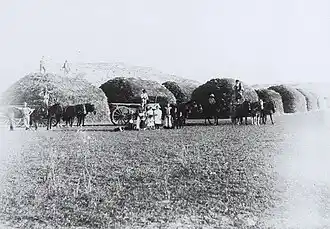
The Argentine Conquest of the Desert occurred between the early 1870s and the mid-1880s as the government of Argentina sought to expand the area of effective governmental control beyond Buenos Aires and its immediate hinterland in the north of the country. Much of it focused on Patagonia, the vast desert-like southern parts of the country. The goal was to expand the amount of land available to Argentine settlers and also to secure control over much of the southern continent during a time when Chile and Argentina were clashing over their respective southern borders. The campaign unfortunately involved extensive attacks on the Mapuche indigenous people and their displacement from their ancestral lands. It did open up much of Argentina to new settlement and many people living in cities and towns in more remote parts of Argentina will be able to trace their roots to ancestors who moved here during the era of the Conquest of the Desert.[1]
Research your ancestors on MyHeritage
Argentine Conquest of the Desert chronology of eventsArgentine Conquest of the Desert chronology of events

Although Argentina is the second largest country in South America today and was the largest state to emerge from the Spanish Empire here, for many centuries it was a country of limited settlement. Buenos Aires was only founded in 1580 by Juan de Garay and for the next two centuries Spanish settlement was largely confined to the city, its immediate hinterland and some ports along the coast. In particular, the central and southern parts of the country remained broadly uninhabited by people of European extraction, as these were deemed to be arid and desert-like lands.[2]
This process began to change in the middle of the nineteenth century. The advent of steamships and the railways brought millions of people from an overpopulated Europe to the Americas and these same people travelled inland to regions Europeans had never considered settling in before as a voracious demand for more and more land developed. Argentina’s population expanded from little more than half a million people in 1800 to nearly five million by 1900 and then doubled again to ten million by the mid-1920s.[3]

In order to acquire more land for settlement and to stop Chile from encroaching into Patagonia and other regions in the south, the Argentine governments of Presidents Nicolás Avellaneda and Julio Argentino Roca oversaw the Conquest of the Desert between the early 1870s and the mid-1880s. This was a military campaign in so far as the Mapuche people and other indigenous groups still predominated here and were resistant to government efforts to resettle them and have them adhere to Argentine law. Similar efforts were underway in Chile, where the process became known as the Occupation of Araucania.[4]
While these campaigns were long seen as necessary acts of government expansion, today they are perceived by some as a form of ethnic cleansing. The Argentine government sent thousands of soldiers armed with modern guns into the central and southern parts of the country. There they forcibly moved tens of thousands of natives to reservations and other regions. Resistance was met with violence and well over a thousand Mapuche and other indigenous people were killed. The campaign was completed in 1884 following a final standoff in Chubut Province.[5]
Extent of migration following the Conquest of the DesertExtent of migration following the Conquest of the Desert

The Conquest of the Desert opened up new lands for European settlers. Many Argentine cities and towns in the center and south of the country owe their foundation to the aftermath of the Conquest. These came from disparate regions. For instance, a colony of Welsh settlers had been formed in Argentina in the mid-1860s and these expanded into Chubut Province in the aftermath of the Conquest, forming a colony known as Y Wladfa in Cymric, meaning ‘The Colony’.[6] Colonies of German settlers, who had been arriving to parts of Chile in growing numbers since the middle of the nineteenth century, also traversed over the border and established settlements in the newly acquired territories. For instance, in the mid-1890s, Carlos Wiederhold, a German Chilean, visited the region and returned several years later to found what is now the city of San Carlos de Bariloche.[7] Others that trekked southwards from Buenos Aires in the 1880s, 1890s and 1900s to Patagonia and beyond included large numbers of Irish and Italians who were arriving to Argentina from Europe in huge numbers during this era.
Demographic impact of the Conquest of the DesertDemographic impact of the Conquest of the Desert

The long term demographic impact of the Conquest of the Desert has been quite substantial. Some of the provinces involved remain the less densely populated parts of Argentina, owing to the inhospitable climate and terrain. But they still have vast populations of people of European descent by comparison with what they used to have prior to the Conquest. For instance, Chubut Province has a population of just over 600,000 people today, nearly all of them of European heritage, where a century and a half ago when the Conquest began there was no more than a few thousand non-native people living here. There are more than three-quarters of a million people in the province of Rio Negro just to the north of Chubut, while the provinces of Mendoza and Neuquén just to the northwest have nearly three million inhabitants between them.[8]
Numerous mid-sized cities have also emerged in the region, notably Santa Rosa and Neuquén, both of which were founded in the twenty years after the Conquest of the Desert and which have 100,000 and 240,000 inhabitants respectively today. Thus, many people living in the central and southern regions of Argentina today have ancestors who moved to those regions in the quarter of a century after the Conquest of the Desert.[9]
See alsoSee also
Explore more about the Argentine Conquest of the DesertExplore more about the Argentine Conquest of the Desert
- Argentina, Baptisms, 1645-1930 records collection on MyHeritage
- Argentina, Marriages, 1722-1911 records collection on MyHeritage
- 1855 Argentina Capital Federal Census records collection on MyHeritage
- 1869 Argentina National Census records collection on MyHeritage
- 1895 Argentina National Census records collection on MyHeritage
- Familias-Argentinas (Argentinian Family Tree) records collection on MyHeritage
- Spanish & Latin American Records on MyHeritage at Legacy Family Tree Webinars
- Research Latin America Genealogical Resources on the Internet at Legacy Family Tree Webinars
References
- ↑ Carolyne R. Larson, The Conquest of the Desert: Argentina’s Indigenous Peoples and the Battle for History (Albuquerque, 2020).
- ↑ Stanley R. Ross and Thomas F. McGann, Buenos Aires; 400 Years (Austin, Texas, 1982).
- ↑ https://www.statista.com/statistics/1066826/total-population-argentina-1800-2020/
- ↑ Alfred Hasbrouck, ‘The Conquest of the Desert’, in The Hispanic American Historical Review, Vol. 15, No. 2 (May, 1935), pp. 195–228.
- ↑ Dante Furioso, ‘Conquest(s) of the Desert’, in Journal of Architectural Education, Vol. 77 (2023), pp. 348–363.
- ↑ https://www.historic-uk.com/HistoryUK/HistoryofWales/The-History-of-Patagonia/
- ↑ https://oxfordre.com/latinamericanhistory/display/10.1093/acrefore/9780199366439.001.0001/acrefore-9780199366439-e-1060
- ↑ https://en.wikipedia.org/wiki/List_of_Argentine_provinces_by_population
- ↑ https://www.indec.gob.ar/indec/web/Nivel4-Tema-2-41-165
